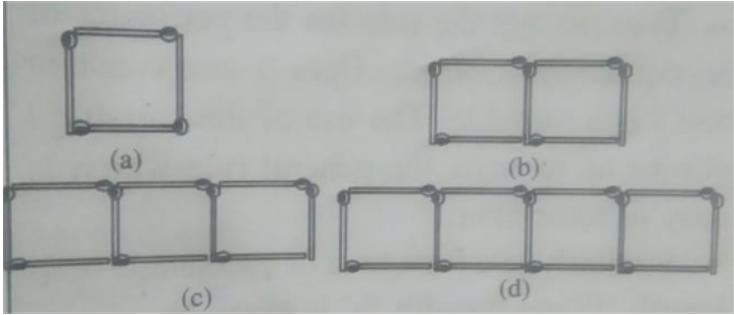Look at the following matchstick pattern of squares. The squares are not separate. Two neighboring squares have a common matchstick. Observe the patterns and find the rule that gives the number of matchsticks in terms of the number of squares. (Hint: If you remove the vertical stick at the end, you will get a pattern of Cs.)
 .Solution in Punjabi
.Solution in Punjabi
Step by step video & image solution for Look at the following matchstick pattern of squares. The squares are not separate. Two neighboring squares have a common matchstick. Observe the patterns and find the rule that gives the number of matchsticks in terms of the number of squares. (Hint: If you remove the vertical stick at the end, you will get a pattern of Cs.). by Maths experts to help you in doubts & scoring excellent marks in Class 6 exams.
Updated on:21/07/2023Topper's Solved these Questions
Similar Questions
Meera has some chocolates.She gave some chocolates to her brother and still she has 7 chocolates with her.If the number of chocolates she gave away is x how many chocolates did she have?
View SolutionCount the number of line segments drawn in each of the following figures and name the:
View Solution(a) Look at the following matchstick pattern of squares (Fig 11.6). The squares are not separate. Two neighbouring squares have a common matchstick. Observe the patterns and find the rule that gives the number of matchsticks in terms of the number of squares. (Hint : If you remove the vertical stick at the end, you will get a pattern of Cs.)(b) Fig 11.7 gives a matchstick pattern of triangles. As in Exercise 11 (a) above, find the general rule that gives the number of matchsticks in terms of the number of triangles.

View Solution(a) तीलियों से बने हुए वर्गों के निचे दिये प्रतिरूपों को देखिए (आकृति 11.6)। ये वर्ग अलग-अलग नहीं है। दो संलग्न वर्गों में एक तीली उभयनिष्ठ है। इस प्रतिरूप को देखिए और वह नियम ज्ञात कीजिए जो वर्गों की संख्या के पदों में आवश्यक तीलियों की संख्या देता है। (संकेत : यदि आप अंतिम ऊर्ध्वाधर तीली को हटा दें, तो आपको C का प्रतिरूप प्राप्त हो जायगा) ।
(b) आकृति 11.7 तीलियों से बना त्रिभुजों का एक प्रतिरूप दर्शा रही है। उपरोक्त प्रश्न 11
(a) की तरह, वह व्यापक नियम ज्ञात कीजिए जो त्रिभुजों की संख्या के पदों में आवश्यक तीलियों की संख्या देता है।
View SolutionThe rule, which gives the number of matchsticks required to make the matchsticks pattern L is
View SolutionThe rule, which gives the number of matchsticks required to make the matchsticks pattern C is
View SolutionThe rule which gives the number of matchsticks required to make the matchstick pattern F is
View SolutionThe rule which gives the number of matchsticks required to make the matchstick pattern ' U ' is
View SolutionThe rule which gives the number of matchsticks required to make the matchsticks pattern 'U'
View Solution(a) Look at the following matchstick pattern of squares (Fig 11.6). The squares are not separate. Two neighbouring squares have a common matchstick. Observe the patterns and find the rule that gives the number of matchsticks in terms of the number of squares. (Hint : If you remove the vertical stick at the end, you will get a pattern of Cs.)(b) Fig 11.7 gives a matchstick pattern of triangles. As in Exercise 11 (a) above, find the general rule that gives the number of matchsticks in terms of the number of triangles.
View SolutionLook at the patterns below the squares made of matchsticks (following figure). These classes are not separate. There is a matchstick in the enclosed sections. Look at this pattern and find the rule that gives the number of matchsticks required in terms of the number of squares. (Hint: If you beat the last hurdle stick, you will get a copy of C)
View Solution(a)Look at the following matchstick pattern of squares (Fig 11.6). The squares are not separate. Two neighbouring squares have a common matchstick. Observe the patterns and find the rule that gives the number of matchsticks in terms of the number of squares. (Hint: If you remove the vertical stick at the end, you will get a pattern of Cs.)
View Solution(a)Look at the following matchstick pattern of squares (Fig 11.6). The squares are not separate. Two neighbouring squares have a common matchstick. Observe the patterns and find the rule that gives the number of matchsticks in terms of the number of squares. (Hint: If you remove the vertical stick at the end, you will get a pattern of Cs.)(c)
View Solution(a)Look at the following matchstick pattern of squares (Fig 11.6). The squares are not separate. Two neighbouring squares have a common matchstick. Observe the patterns and find the rule that gives the number of matchsticks in terms of the number of squares. (Hint: If you remove the vertical stick at the end, you will get a pattern of Cs.)(d)
View SolutionLook at the following matchstick pattern of squares. The squares are not separate. Two neighboring squares have a common matchstick. Observe the patterns and find the rule that gives the number of matchsticks in terms of the number of squares. (Hint: If you remove the vertical stick at the end, you will get a pattern of Cs.)
View Solution
